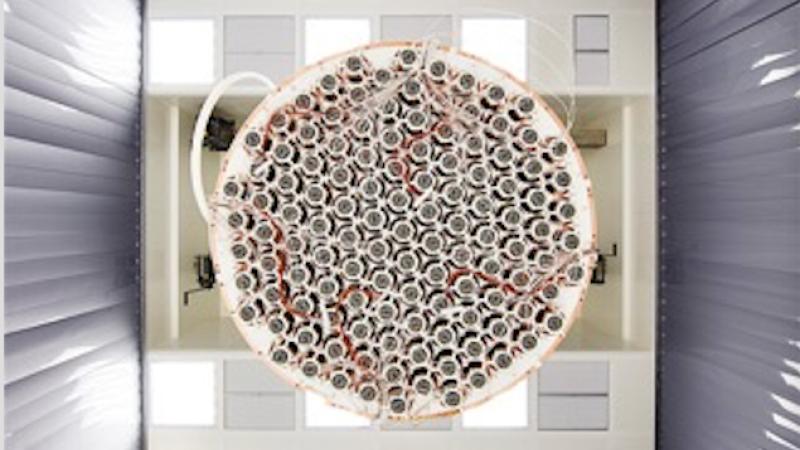The world’s most sensitive dark matter detector demonstrates record low radioactivity levels
August 22, 2017

Results from its first run indicate that XENON1T is the most sensitive dark matter detector on Earth. The sensitivity of the detector – an underground sentinel awaiting a collision that would confirm a hypothesis – stems from both its size and its “silence.” Shielded by rock and water, and purified with a sophisticated system, the detector demonstrated a new record low radioactivity level, many orders of magnitude below surrounding material on Earth.
“We are seeing very good quality data from this detector, which tells us that it is running perfectly,” said Ethan Brown, a XENON1T Collaboration member, and assistant professor of physics, applied physics, and astronomy at Rensselaer Polytechnic Institute.
Dark matter is theorized as one of the basic constituents of the universe, five times more abundant than ordinary matter. But because it cannot be seen and seldom interacts with ordinary matter, its existence has never been confirmed. Several astronomical measurements have corroborated the existence of dark matter, leading to a worldwide effort to directly observe dark matter particle interactions with ordinary matter. Up to the present, the interactions have proven so feeble that they have escaped direct detection, forcing scientists to build ever-more-sensitive detectors.
Since 2006, the XENON Collaboration has operated three successively more sensitive liquid xenon detectors in the Gran Sasso Underground Laboratory (LNGS) in Italy, and XENON1T is its most powerful venture to date and the largest detector of its type ever built. Particle interactions in liquid xenon create tiny flashes of light, and the detector is intended to capture the flash from the rare occasion in which a dark matter particle collides with a xenon nucleus.
But other interactions are far more common. To shield the detector as much as possible from natural radioactivity in the cavern, the detector (a so-called Liquid Xenon Time Projection Chamber) sits within a cryostat submersed in a tank of water. A mountain above the underground laboratory further shields the detector from cosmic rays. Even with shielding from the outside world, contaminants seep into the xenon from the materials used in the detector. Among his contributions, Brown is responsible for a purification system that continually scrubs the xenon in the detector.
“If the xenon is dirty, we won’t see the signal from a collision with dark matter,” Brown said. “Keeping the xenon clean is one of the major challenges of this experiment, and my work involves developing new techniques and new technologies to keep pace with that challenge.”
Brown also aids in calibrating the detector to ensure that interactions which are recorded can be properly identified. In rare cases, for example, the signal from a gamma ray may approach the expected signal of a dark matter particle, and proper calibration helps to rule out similar false positive signals.
In the paper “First Dark Matter Search Results from the XENON1T Experiment” posted on arXiv.org and submitted for publication, the collaboration presented results of a 34-day run of XENON1T from November 2016 to January 2017. While the results did not detect dark matter particles – known as “weakly interacting massive particles” or “WIMPs” – the combination of record low radioactivity levels with the size of the detector implies an excellent discovery potential in the years to come.
“A new phase in the race to detect dark matter with ultralow background massive detectors on Earth has just began with XENON1T,” said Elena Aprile, a professor at Columbia University and project spokesperson. “We are proud to be at the forefront of the race with this amazing detector, the first of its kind.”
The XENON Collaboration consists of 135 researchers from the U.S., Germany, Italy, Switzerland, Portugal, France, the Netherlands, Israel, Sweden, and the United Arab Emirates.
Brown’s research is enabled by the vision of The New Polytechnic, an emerging paradigm for higher education which recognizes that global challenges and opportunities are so great they cannot be adequately addressed by even the most talented person working alone. Rensselaer serves as a crossroads for collaboration — working with partners across disciplines, sectors, and geographic regions — to address complex global challenges, using the most advanced tools and technologies, many of which are developed at Rensselaer. Research at Rensselaer addresses some of the world’s most pressing technological challenges — from energy security and sustainable development to biotechnology and human health. The New Polytechnic is transformative in the global impact of research, in its innovative pedagogy, and in the lives of students at Rensselaer.
About Rensselaer Polytechnic Institute
Rensselaer Polytechnic Institute, founded in 1824, is America’s first technological research university. For nearly 200 years, Rensselaer has been defining the scientific and technological advances of our world. Rensselaer faculty and alumni represent 85 members of the National Academy of Engineering, 17 members of the National Academy of Sciences, 25 members of the American Academy of Arts and Sciences, 8 members of the National Academy of Medicine, 8 members of the National Academy of Inventors, and 5 members of the National Inventors Hall of Fame, as well as 6 National Medal of Technology winners, 5 National Medal of Science winners, and a Nobel Prize winner in Physics. With 7,000 students and nearly 100,000 living alumni, Rensselaer is addressing the global challenges facing the 21st century—to change lives, to advance society, and to change the world. To learn more, go to www.rpi.edu.